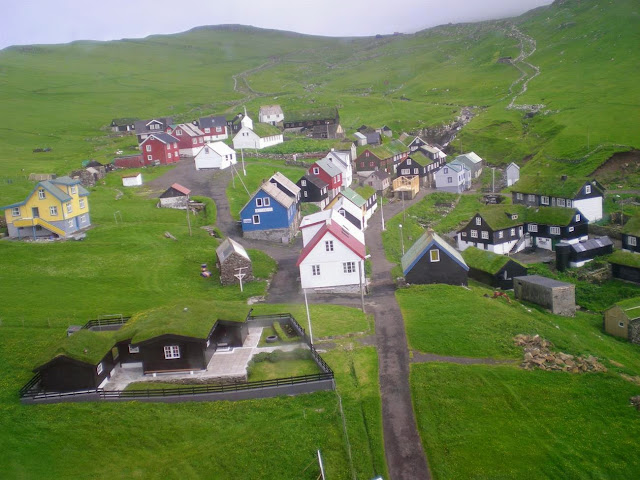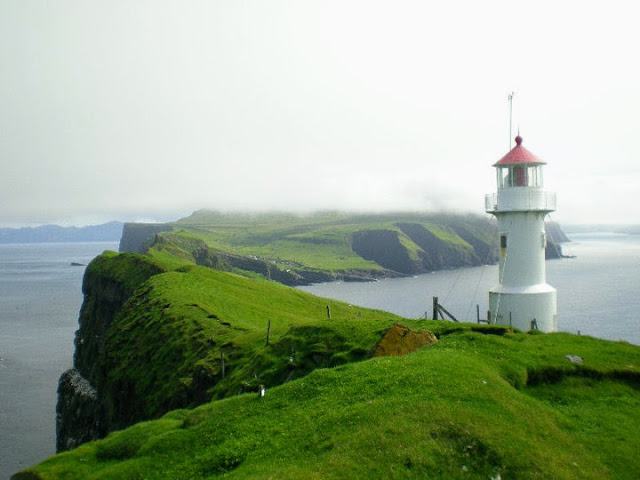A few years ago, I spent the summer on the Faroe Islands working at a small guesthouse on a remote island called Mykines. It was one of the greatest experiences I have had, and staying with a local family gave me the opportunity to see how the locals live.
The Faroe Islands is a group of islands in the Atlantic Ocean, located halfway between Iceland and Scotland. The islands belong to Denmark, but they are self-governed. They also have their own language, Faroese, which descends from Old Norse but they learn Danish and English at school and many of them are comfortable speaking Norwegian and Swedish as well.
There are about 50.000 inhabitants on the Faroe Islands, but less than 10 of them are living in Mykines village, which is the only village on Mykines. The village does have quite a few houses which are mainly used as summer houses, so the village is quite lively in the summer which was the case when I was there.
To get to and from Mykines, I had to take a boat which only runs twice daily, weather permitting. This boat is only running in the summer months. There's also a helicopter service that runs twice a week throughout the year and that is a bit more expensive than the boat, but a good alternative when the waves are too high for the boat to run. I had to take the helicopter a few times and it was an incredible experience with spectacular views. The helicopter is also transporting food to the inhabitants on the island. The family I was staying with told me that especially during the winter period they sometimes stay isolated from the mainland for weeks as the weather is too bad for the helicopter to run safely. The picture below shows you how bad it can be, and just to be clear; this picture is not a black and white picture, it's showing the real colours during one of the storms...
One of my favorite things about the Faroe Islands is that you can walk almost anywhere. During summer time there are green landscapes as far as you can see. You don't need to follow a path as long as you are respectful to the nature and of other people's properties, and that you know at all times how to get back to your starting point as the weather changes really fast. It can change from sunshine to packed mist in minutes, and you do not want to get lost in the middle of nowhere without phone connection! The temperatures on the Faroe Islands are 3 (winter) and 11 (summer) degrees Celsius on average, but that doesn't stop those hardcore islanders from wearing t-shirts during the summer months.
The birds are also one of the reasons why people come to the Faroe Islands. Especially Mykines is well known to ornithologists and people who are generally interested in birds and photography.
Most people visiting Mykines would do the hike that starts at the village and ends at a light house on the small islet of Mykinesholmur. The majority of the bird colonies are also living on this islet. I think this walk has really stunning scenery, but I still preferred to go off on my own little adventures away from the rest of the people, finding my own path as I was walking.
Bird is also a local delicacy, especially the puffin and the gannet. At the end of the summer, the father and the son of my Faroese family went out in the night time together with some other local men and caught puffins and gannets themselves while literally hanging off the cliffs in ropes! The next day I got invited to a proper Faroese dinner where I got served gannet. I found it very tasty as it tasted almost like chicken, my favorite meat. Then the following day, puffin was on the menu. It was served in its full shape, with feet and all. I have to admit the taste was not my cup of tea, but I'm still glad I tried it.
Another famous animal on the Faroe Islands is the sheep. They're everywhere. The islands are actually home to more sheep than people. This explains the local fashion which contains a lot of wool: knitted jumpers, scarfs, hats etc. I bought myself one of those jumpers and they are warm! When wearing them, you'll never be cold during winter ever again! After all, this wool is made to protect the Faroese sheep from the rough winds and rain.
I also visited other islands and villages than Mykines during my stay, and will write more about that in another post...
The Faroe Islands is a group of islands in the Atlantic Ocean, located halfway between Iceland and Scotland. The islands belong to Denmark, but they are self-governed. They also have their own language, Faroese, which descends from Old Norse but they learn Danish and English at school and many of them are comfortable speaking Norwegian and Swedish as well.
There are about 50.000 inhabitants on the Faroe Islands, but less than 10 of them are living in Mykines village, which is the only village on Mykines. The village does have quite a few houses which are mainly used as summer houses, so the village is quite lively in the summer which was the case when I was there.
To get to and from Mykines, I had to take a boat which only runs twice daily, weather permitting. This boat is only running in the summer months. There's also a helicopter service that runs twice a week throughout the year and that is a bit more expensive than the boat, but a good alternative when the waves are too high for the boat to run. I had to take the helicopter a few times and it was an incredible experience with spectacular views. The helicopter is also transporting food to the inhabitants on the island. The family I was staying with told me that especially during the winter period they sometimes stay isolated from the mainland for weeks as the weather is too bad for the helicopter to run safely. The picture below shows you how bad it can be, and just to be clear; this picture is not a black and white picture, it's showing the real colours during one of the storms...
One of my favorite things about the Faroe Islands is that you can walk almost anywhere. During summer time there are green landscapes as far as you can see. You don't need to follow a path as long as you are respectful to the nature and of other people's properties, and that you know at all times how to get back to your starting point as the weather changes really fast. It can change from sunshine to packed mist in minutes, and you do not want to get lost in the middle of nowhere without phone connection! The temperatures on the Faroe Islands are 3 (winter) and 11 (summer) degrees Celsius on average, but that doesn't stop those hardcore islanders from wearing t-shirts during the summer months.
The birds are also one of the reasons why people come to the Faroe Islands. Especially Mykines is well known to ornithologists and people who are generally interested in birds and photography.
Most people visiting Mykines would do the hike that starts at the village and ends at a light house on the small islet of Mykinesholmur. The majority of the bird colonies are also living on this islet. I think this walk has really stunning scenery, but I still preferred to go off on my own little adventures away from the rest of the people, finding my own path as I was walking.
Bird is also a local delicacy, especially the puffin and the gannet. At the end of the summer, the father and the son of my Faroese family went out in the night time together with some other local men and caught puffins and gannets themselves while literally hanging off the cliffs in ropes! The next day I got invited to a proper Faroese dinner where I got served gannet. I found it very tasty as it tasted almost like chicken, my favorite meat. Then the following day, puffin was on the menu. It was served in its full shape, with feet and all. I have to admit the taste was not my cup of tea, but I'm still glad I tried it.
Another famous animal on the Faroe Islands is the sheep. They're everywhere. The islands are actually home to more sheep than people. This explains the local fashion which contains a lot of wool: knitted jumpers, scarfs, hats etc. I bought myself one of those jumpers and they are warm! When wearing them, you'll never be cold during winter ever again! After all, this wool is made to protect the Faroese sheep from the rough winds and rain.
I also visited other islands and villages than Mykines during my stay, and will write more about that in another post...





Comments
Post a Comment